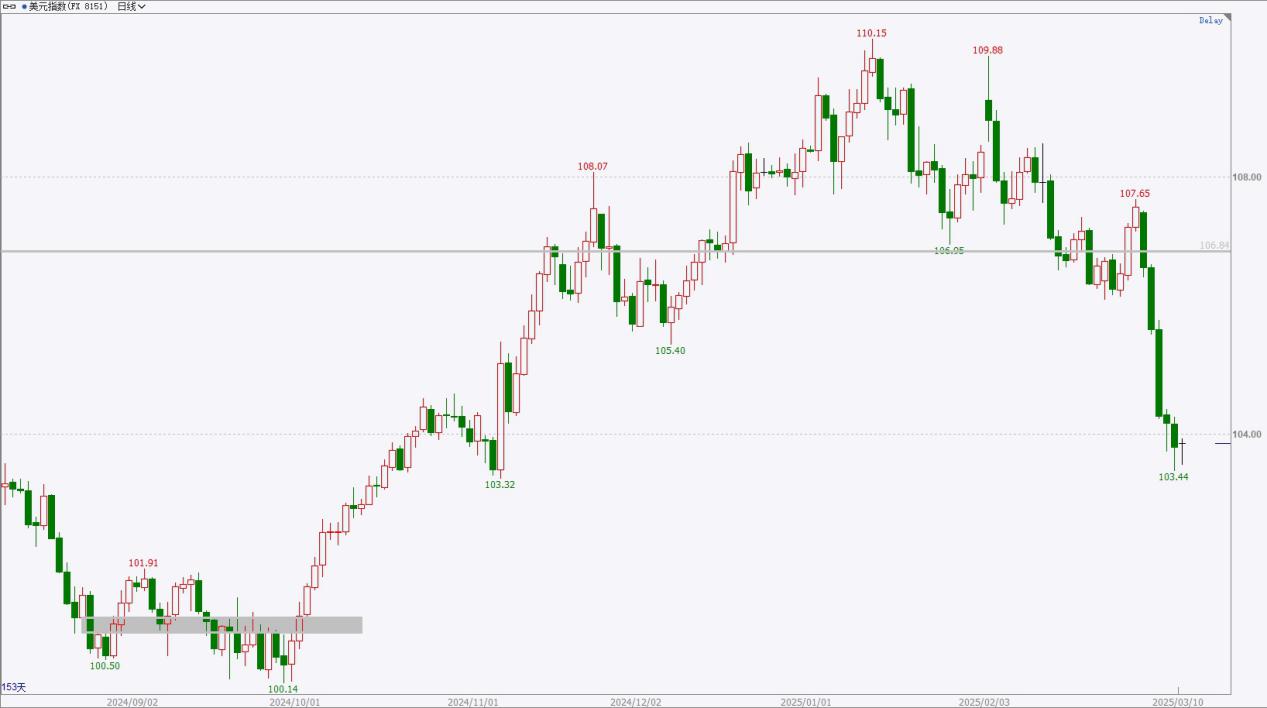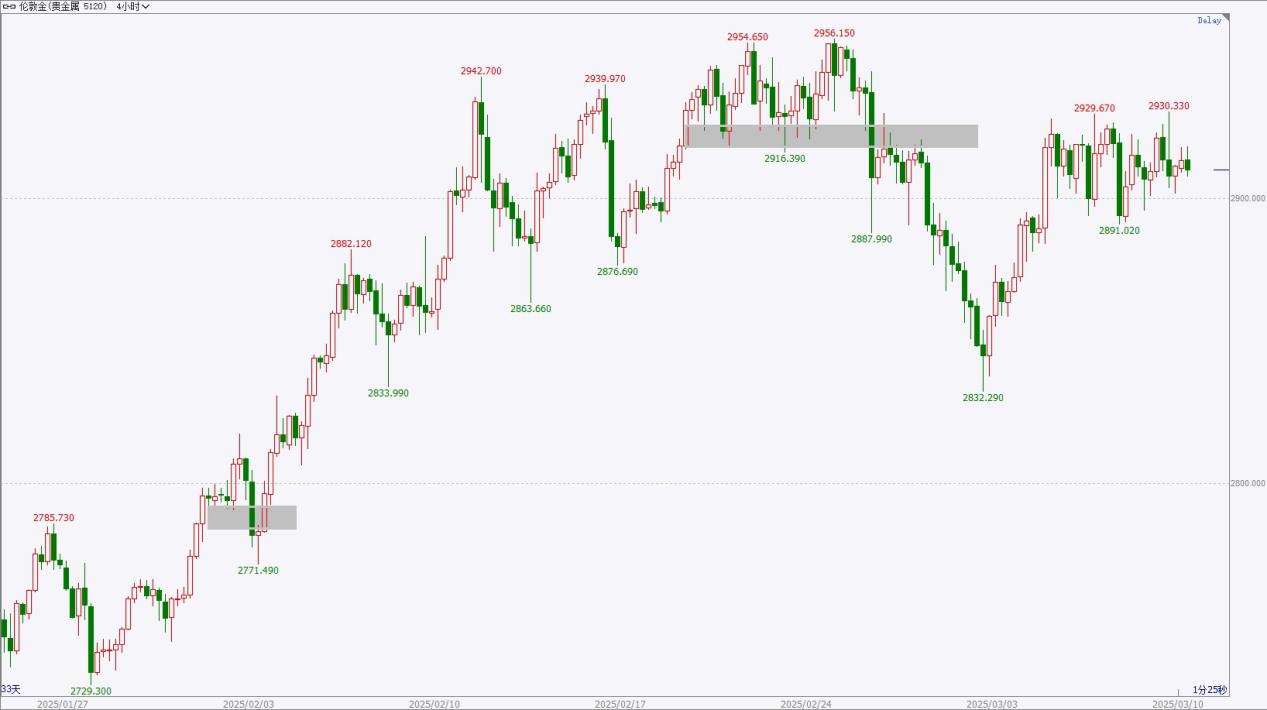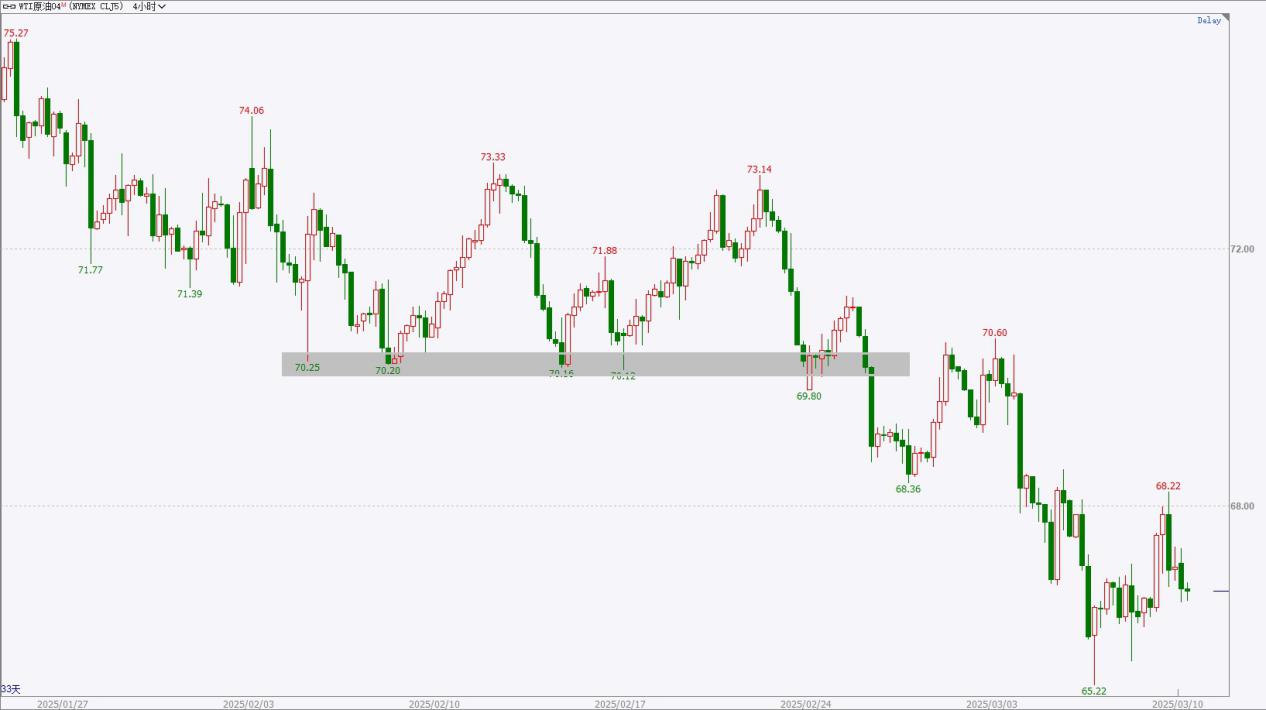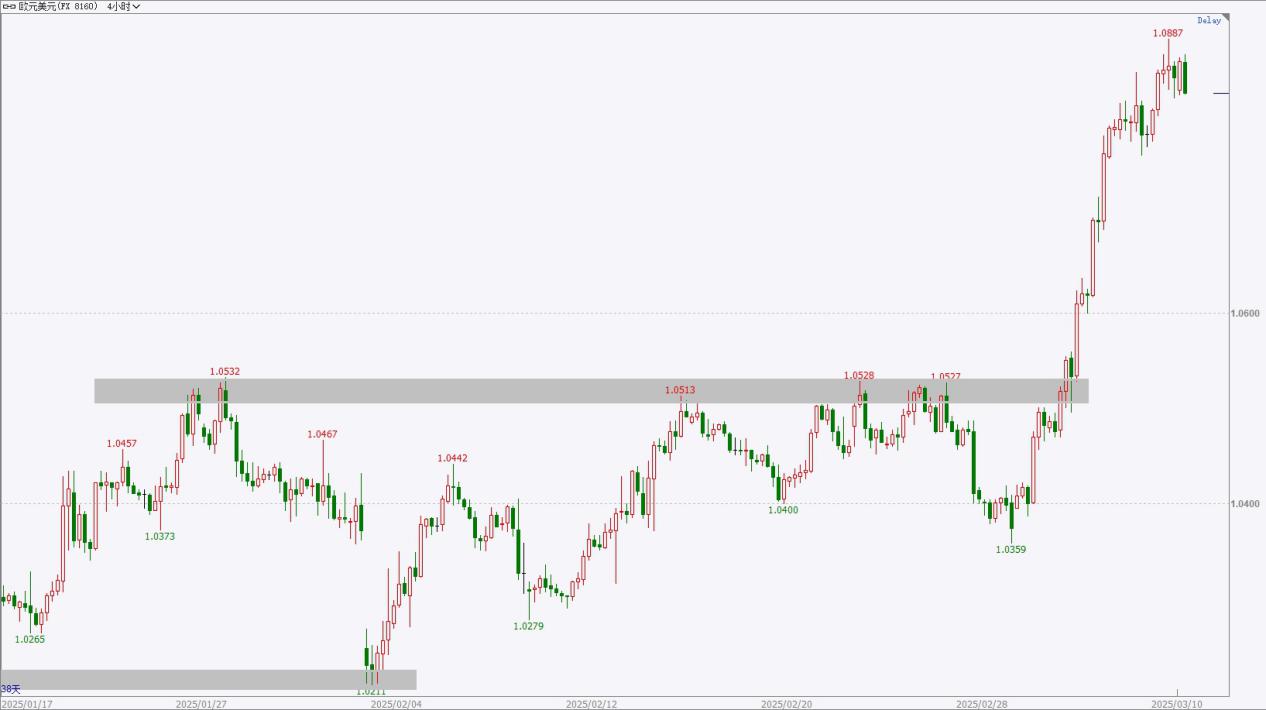|
Time
|
Data and Events
|
Importance
|
|
07:50
|
Japan’s January Trade Balance
|
★★★
|
|
15:00
|
Germany’s January Seasonally Adjusted Industrial Production Monthly Rate
|
★★★
|
|
Germany’s January Seasonally Adjusted Trade Balance
|
★★★
|
|
16:00
|
Switzerland’s February Consumer Confidence Index
|
★★★
|
|
17:30
|
Eurozone’s March Sentix Investor Confidence Index
|
★★★
|
|
23:00
|
U.S. February New York Fed 1-Year Inflation Expectation
|
★★★
|
|
Variety
|
Viewpoint
|
Support Range
|
Pressure Range
|
|
Dollar Index
|
Fluctuating Weak
|
103.5-104
|
107-107.5
|
|
Gold
|
Short-term Rebound
|
2830-2850
|
2920-2930
|
|
Crude Oil
|
Fluctuating Weak
|
65-66
|
70-71
|
|
Euro
|
Fluctuating Strong
|
1.0450-1.0500
|
1.0850-1.0900
|
*Pre-market views are time-sensitive and limited in scope, are predictions only, and are for reference and learning purposes, not constituting investment advice. The risk of investment lies with the trader; proceed with caution.
Fundamental Analysis:
At the end of January, the Federal Reserve held the interest rate steady; the labor market remained strong, economic activity expanded steadily, and inflation levels still appeared slightly high, leading to a cooling of expectations for monetary policy easing, with attention on new government policies. In February, non-farm employment data recorded an increase of 151,000 jobs, slightly below expectations, with the unemployment rate rising to 4.1%, indicating a slight easing in the labor market. The January non-seasonally adjusted CPI year-on-year rate was recorded at 3.0%, slightly above previous values and expectations. The year-on-year core PCE price index for January fell slightly, in line with expectations.
Technical Analysis:

The Dollar Index has recently shown weak performance, with daily fluctuations trending downward, currently in a support area; the pace of declines in shorter cycles is slowing down, suggesting possible fluctuations or rebounds, with a strategy of reducing short positions on dips. Overall, after high-level fluctuations, signs of weakening are observed, and a short-term continuation of the weak retracement is expected. The upper pressure zone is around 107-107.5, while the lower support zone is around 103.5-104.
Viewpoint: Fluctuating weak; the pace of declines in shorter cycles is slowing down; reduce short positions to take profits on dips if applicable.
*Pre-market views are time-sensitive and limited in scope, are predictions only, and are for reference and learning purposes, not constituting investment advice. The risk of investment lies with the trader; proceed with caution.
Fundamental Analysis:
The ongoing deterioration of geopolitical conflicts in the Middle East and the easing of the situation in Eastern Europe present uncertainties. In early March, the ECB’s interest rate decision marked the fifth consecutive rate cut of 25 basis points, with smooth progress on inflation and a downward risk to economic growth. At the end of January, the Federal Reserve’s interest rate decision maintained rates steady, with strong economic activity but still high inflation levels, alleviating expectations for rate cuts. In February, U.S. non-farm data showed slight easing, with new jobs slightly below expectations and an unemployment rate rising to 4.1%; the January CPI year-on-year rate showed a slight rise, marginally above expectations.
Technical Analysis:

Recently, gold prices have trended in fluctuations, with daily performance flat; short-term trading is intense, currently near the pressure zone, with no clear upward breakthrough. Reduce long positions on highs to take profits; if there is a break above this structure, the market may turn strong, otherwise, be cautious of a retracement risk. From a larger cycle perspective, the ascending structure is intact with daily fluctuations moving upward; attention is on whether prices can reach new highs. Upper pressure levels could be around 2920-2930, while lower minor support levels could be around 2830-2850.
Viewpoint: Short-term rebound, approaching pressure structure, watch to see if a break occurs.
*Pre-market views are time-sensitive and limited in scope, are predictions only, and are for reference and learning purposes, not constituting investment advice. The risk of investment lies with the trader; proceed with caution.
Fundamental Analysis:
The February EIA monthly report maintains the forecast for global crude oil demand growth for this year and next, with a slight adjustment to the 2025 crude oil price; the OPEC monthly report also maintains the forecast for global crude oil demand growth for this year and next; the IEA monthly report slightly raises the forecast for global oil demand growth in 2025. At the beginning of February, the OPEC+ meeting adhered to the previous oil production agreement, with the committee agreeing to gradually increase oil production starting from April 1, in line with previous plans. EIA crude oil inventories have increased significantly, which may put pressure on oil prices, necessitating attention to changes in the supply-demand structure.
Technical Analysis:

U.S. crude oil performed weakly last week, with daily fluctuations trending downwards, prices are at relatively low levels, and a rebound is occurring in the short cycle, but there is still selling pressure above, likely resulting in a short-term sideways structure. If there are short positions, consider reducing holdings to take profits during dips. Overall, crude oil prices are fluctuating and correcting at low levels, with no signs of stabilizing. The upper pressure area is around 70-71, while the lower support area is around 65-66.
Viewpoint: Fluctuating weakly near the support area, consider reducing holdings to take profits during dips if there are short positions.
*Pre-market views are time-sensitive and limited in scope, are predictions only, and are for reference and learning purposes, not constituting investment advice. The risk of investment lies with the trader; proceed with caution.
Fundamental Analysis:
The European Central Bank’s interest rate decision at the beginning of March resulted in a consecutive fifth cut of 25 basis points, with a smooth decline in inflation progress and a slight downward adjustment of GDP growth forecasts for this year and next, indicating economic growth risks are skewed to the downside, and tariffs may bring negative impacts. At the end of January, the Federal Reserve’s interest rate decision maintained interest rates unchanged, reflecting a strong overall economic performance and easing expectations. U.S. non-farm data for February showed a slight slowdown, with job growth slightly below expectations and the unemployment rate rising slightly to 4.1%; the January CPI in the U.S. saw a small uptick. The Eurozone manufacturing PMI showed little change.
Technical Analysis:

The euro saw a significant increase last week, with small cycles consistently hitting new highs and a strong short-term performance. Currently, it is at a small level pressure point, where selling pressure may exist. Consider reducing holdings to take profits on long positions while monitoring whether the price can break through the pressure point. Overall, the price is at relatively low levels, displaying a daily fluctuation structure and may show signs of stabilizing at a larger scale. The upper small-level pressure area is around 1.0850-1.0900, while the lower support area is around 1.0450-1.0500.
Viewpoint: Fluctuating strongly, consider reducing holdings to take profits on long positions, and monitor whether the price can break through the pressure point again.
*Pre-market views are time-sensitive and limited in scope, are predictions only, and are for reference and learning purposes, not constituting investment advice. The risk of investment lies with the trader; proceed with caution.


Daily Reviews
Our award-winning team of analysts provides keen and insightful technical and fundamental analysis to understand daily market news and investment trading opportunities
HTFX Daily Forex Commentary 0310
Time
Data and Events
Importance
07:50
Japan’s January Trade Balance
★★★
15:00
Germany’s January Seasonally Adjusted Industrial Production Monthly Rate
★★★
Germany’s January Seasonally Adjusted Trade Balance
★★★
16:00
Switzerland’s February Consumer Confidence Index
★★★
17:30
Eurozone’s March Sentix Investor Confidence Index
★★★
23:00
U.S. February New York Fed 1-Year Inflation Expectation
★★★
Variety
Viewpoint
Support Range
Pressure Range
Dollar Index
Fluctuating Weak
103.5-104
107-107.5
Gold
Short-term Rebound
2830-2850
2920-2930
Crude Oil
Fluctuating Weak
65-66
70-71
Euro
Fluctuating Strong
1.0450-1.0500
1.0850-1.0900
*Pre-market views are time-sensitive and limited in scope, are predictions only, and are for reference and learning purposes, not constituting investment advice. The risk of investment lies with the trader; proceed with caution.
Fundamental Analysis:
At the end of January, the Federal Reserve held the interest rate steady; the labor market remained strong, economic activity expanded steadily, and inflation levels still appeared slightly high, leading to a cooling of expectations for monetary policy easing, with attention on new government policies. In February, non-farm employment data recorded an increase of 151,000 jobs, slightly below expectations, with the unemployment rate rising to 4.1%, indicating a slight easing in the labor market. The January non-seasonally adjusted CPI year-on-year rate was recorded at 3.0%, slightly above previous values and expectations. The year-on-year core PCE price index for January fell slightly, in line with expectations.
Technical Analysis:
The Dollar Index has recently shown weak performance, with daily fluctuations trending downward, currently in a support area; the pace of declines in shorter cycles is slowing down, suggesting possible fluctuations or rebounds, with a strategy of reducing short positions on dips. Overall, after high-level fluctuations, signs of weakening are observed, and a short-term continuation of the weak retracement is expected. The upper pressure zone is around 107-107.5, while the lower support zone is around 103.5-104.
Viewpoint: Fluctuating weak; the pace of declines in shorter cycles is slowing down; reduce short positions to take profits on dips if applicable.
*Pre-market views are time-sensitive and limited in scope, are predictions only, and are for reference and learning purposes, not constituting investment advice. The risk of investment lies with the trader; proceed with caution.
Fundamental Analysis:
The ongoing deterioration of geopolitical conflicts in the Middle East and the easing of the situation in Eastern Europe present uncertainties. In early March, the ECB’s interest rate decision marked the fifth consecutive rate cut of 25 basis points, with smooth progress on inflation and a downward risk to economic growth. At the end of January, the Federal Reserve’s interest rate decision maintained rates steady, with strong economic activity but still high inflation levels, alleviating expectations for rate cuts. In February, U.S. non-farm data showed slight easing, with new jobs slightly below expectations and an unemployment rate rising to 4.1%; the January CPI year-on-year rate showed a slight rise, marginally above expectations.
Technical Analysis:
Recently, gold prices have trended in fluctuations, with daily performance flat; short-term trading is intense, currently near the pressure zone, with no clear upward breakthrough. Reduce long positions on highs to take profits; if there is a break above this structure, the market may turn strong, otherwise, be cautious of a retracement risk. From a larger cycle perspective, the ascending structure is intact with daily fluctuations moving upward; attention is on whether prices can reach new highs. Upper pressure levels could be around 2920-2930, while lower minor support levels could be around 2830-2850.
Viewpoint: Short-term rebound, approaching pressure structure, watch to see if a break occurs.
*Pre-market views are time-sensitive and limited in scope, are predictions only, and are for reference and learning purposes, not constituting investment advice. The risk of investment lies with the trader; proceed with caution.
Fundamental Analysis:
The February EIA monthly report maintains the forecast for global crude oil demand growth for this year and next, with a slight adjustment to the 2025 crude oil price; the OPEC monthly report also maintains the forecast for global crude oil demand growth for this year and next; the IEA monthly report slightly raises the forecast for global oil demand growth in 2025. At the beginning of February, the OPEC+ meeting adhered to the previous oil production agreement, with the committee agreeing to gradually increase oil production starting from April 1, in line with previous plans. EIA crude oil inventories have increased significantly, which may put pressure on oil prices, necessitating attention to changes in the supply-demand structure.
Technical Analysis:
U.S. crude oil performed weakly last week, with daily fluctuations trending downwards, prices are at relatively low levels, and a rebound is occurring in the short cycle, but there is still selling pressure above, likely resulting in a short-term sideways structure. If there are short positions, consider reducing holdings to take profits during dips. Overall, crude oil prices are fluctuating and correcting at low levels, with no signs of stabilizing. The upper pressure area is around 70-71, while the lower support area is around 65-66.
Viewpoint: Fluctuating weakly near the support area, consider reducing holdings to take profits during dips if there are short positions.
*Pre-market views are time-sensitive and limited in scope, are predictions only, and are for reference and learning purposes, not constituting investment advice. The risk of investment lies with the trader; proceed with caution.
Fundamental Analysis:
The European Central Bank’s interest rate decision at the beginning of March resulted in a consecutive fifth cut of 25 basis points, with a smooth decline in inflation progress and a slight downward adjustment of GDP growth forecasts for this year and next, indicating economic growth risks are skewed to the downside, and tariffs may bring negative impacts. At the end of January, the Federal Reserve’s interest rate decision maintained interest rates unchanged, reflecting a strong overall economic performance and easing expectations. U.S. non-farm data for February showed a slight slowdown, with job growth slightly below expectations and the unemployment rate rising slightly to 4.1%; the January CPI in the U.S. saw a small uptick. The Eurozone manufacturing PMI showed little change.
Technical Analysis:
The euro saw a significant increase last week, with small cycles consistently hitting new highs and a strong short-term performance. Currently, it is at a small level pressure point, where selling pressure may exist. Consider reducing holdings to take profits on long positions while monitoring whether the price can break through the pressure point. Overall, the price is at relatively low levels, displaying a daily fluctuation structure and may show signs of stabilizing at a larger scale. The upper small-level pressure area is around 1.0850-1.0900, while the lower support area is around 1.0450-1.0500.
Viewpoint: Fluctuating strongly, consider reducing holdings to take profits on long positions, and monitor whether the price can break through the pressure point again.
*Pre-market views are time-sensitive and limited in scope, are predictions only, and are for reference and learning purposes, not constituting investment advice. The risk of investment lies with the trader; proceed with caution.
Latest Reviews
HTFX Daily Forex Commentary 0819
HTFX Daily Forex Commentary 0815
HTFX Daily Forex Commentary 0812
HTFX Daily Forex Commentary 0811
Choose a Trusted Broker for Trading
Over 300 employees worldwide, more than 1,000 products, top-tier liquidity